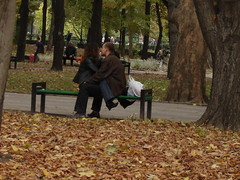Saturday, November 05, 2005
My Impressions of Moldova
1. It's Europe!
Chisinau is a European city: the architecture is European, the fashion is European (moreso the men's fashions), the atmosphere is European. I don't know why I expected anything else, but I was surprised that I saw so many things (architecture, clothing styles) in common with Berlin.
2. There is a different dynamic between men and women than in the U.S.
In Moldova, men always help a women get out of a vehicle, carry her bag (even a purse), fill her glass before it's emptied (whether it be wine or cognac- you can imagine how easy it is to drink a bit too much!), and give kisses on the cheek instead of shaking hands. It almost seems old-fashioned to me. Being treated in such a way (being treated like a lady?) was cute and quaint at first, but I think it would get frustrating and old after a while. Of course, to Moldovan women, this is all completely acceptable and desirable behavior.
3. Women wear pointy shoes.
I felt very plain and frumpy in my round-toed shoes. I've never before seen such long, pointy shoes with dangerously high heels. Sometimes the toes also turned up at the point.
4. The people work very hard for very little pay.
We were working with young teachers/lecturers at Moldova State University. They teach often five to six classes a day, six days a week. Besides the time spent in the classroom, these teachers need to prepare lectures for five or six different lectures every day. The average professor in the United States would teach 2-6 lectures a week. That's a huge difference (granted the professors in the U.S. are also expected to be doing research and have advising and administrative duties). In Moldova, for all their long hours, the teachers get paid about fifty dollars a month. This forces people to live at home in their twenties and sometimes in to their thirties.
5. Items were more expensive than I had expected.
Some things were very inexpensive. A ride on a maxi-taxi was only twenty cents. Food was also inexpensive- although there was not a great variety of fruits and vegetables. However, clothing prices were comparable to the rest of Europe. Obviously, someone can not afford to buy a sweater for forty dollars or some jeans for ninety dollars when he or she only makes fifty dollars a month. I asked Irina, a Moldovan teacher, how she was able to afford such expensive clothes, and she pointed out that she had knit the sweater she was wearing. The sweater was gorgeous and looked like it came straight from H+M.
Subscribe to:
Posts (Atom)

